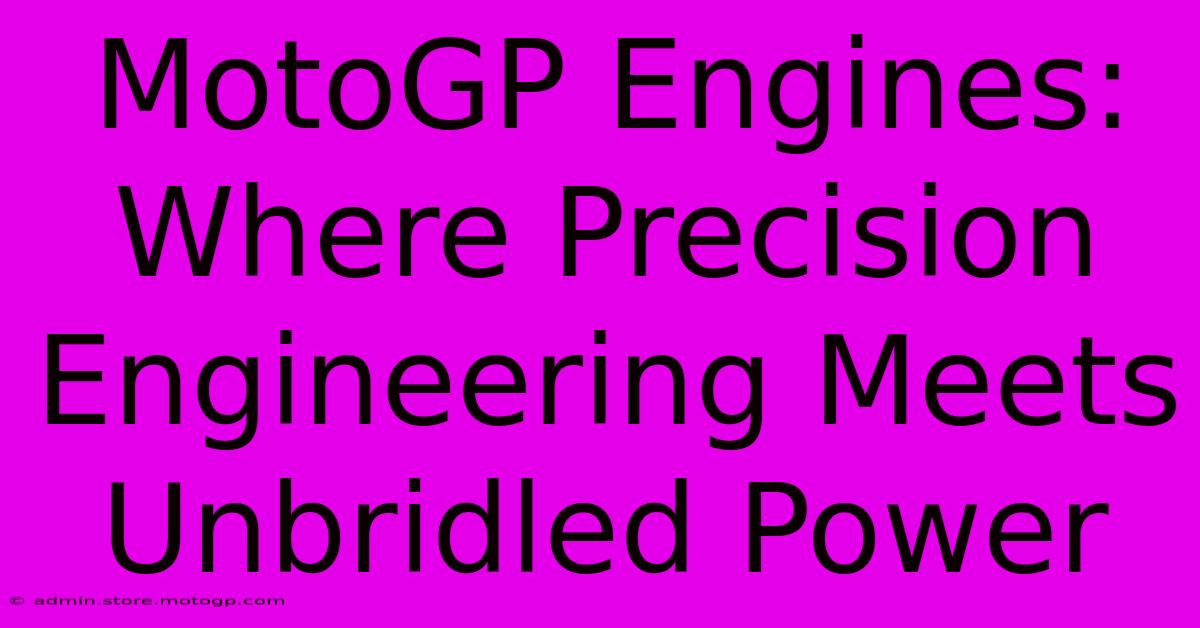MotoGP Engines: Where Precision Engineering Meets Unbridled Power

Table of Contents
MotoGP Engines: Where Precision Engineering Meets Unbridled Power
MotoGP. The name alone evokes images of screaming engines, breathtaking speeds, and the ultimate test of rider skill. But behind the spectacle of lean angles and daring overtakes lies a marvel of engineering: the MotoGP engine. These aren't your average motorcycle engines; they are meticulously crafted powerhouses, representing the pinnacle of internal combustion technology. This article delves into the heart of these beasts, exploring the precision engineering and unbridled power that define them.
The Heart of the Beast: Engine Specifications and Design
MotoGP engines are complex pieces of machinery, with stringent regulations dictating their design and performance. Currently, the class utilizes four-stroke, 1000cc inline four-cylinder engines, though the specific configurations vary from manufacturer to manufacturer. These aren't just powerful; they are incredibly lightweight and compact, demanding advanced materials and manufacturing processes.
Key Features Driving Performance:
- High Revving Capabilities: MotoGP engines are designed to operate at extremely high RPMs, often exceeding 18,000 revolutions per minute. This high-revving nature contributes significantly to their power output.
- Lightweight Materials: The use of exotic materials like titanium, magnesium, and carbon fiber is crucial for reducing weight without sacrificing strength or durability. Every gram saved translates directly to improved performance.
- Sophisticated Electronics: Modern MotoGP bikes are heavily reliant on advanced electronics, managing everything from fuel injection and ignition timing to traction control and wheelie control. These systems optimize engine performance and rider safety.
- Pneumatic Valve Actuation: Some manufacturers utilize pneumatic valve actuation systems, allowing for incredibly precise control of valve timing and lift, maximizing efficiency and power across the rev range.
- Seamless Gear Shifting: Quick-shifters allow riders to change gears without using the clutch, maintaining momentum and providing a significant advantage during races.
Precision Engineering: The Art of the Build
Building a MotoGP engine is far from a simple assembly process. It requires the highest level of precision and expertise. Each component is meticulously crafted, inspected, and tested to ensure it meets the exacting standards demanded by the sport.
The Importance of Tight Tolerances:
- Micron-Level Accuracy: Tolerances in MotoGP engine components are measured in microns – thousandths of a millimeter. This extreme precision is crucial for ensuring optimal performance and reliability.
- Rigorous Quality Control: Every part undergoes rigorous testing and quality control procedures before being incorporated into the engine. This ensures the engine performs flawlessly under the extreme stress of a MotoGP race.
Unbridled Power: Harnessing the Force
The power output of a MotoGP engine is simply staggering. These engines routinely produce over 260 horsepower, delivering incredible acceleration and top speeds. But it's not just the raw power; it's the responsiveness and controllability that sets these engines apart.
Power Delivery and Control:
- Precise Fuel Injection: Advanced fuel injection systems deliver precise amounts of fuel to the cylinders, optimizing combustion and power delivery.
- Sophisticated Engine Management Systems: These systems manage various engine parameters, ensuring optimal performance in a wide range of conditions.
- Aerodynamics: The power generated by the engine is further enhanced by the bike’s aerodynamics, which reduce drag and improve stability at high speeds.
The Future of MotoGP Engines
The technology behind MotoGP engines constantly evolves. Manufacturers are continually pushing boundaries, seeking marginal gains in performance and efficiency. Expect to see further advancements in materials science, electronics, and engine design in the years to come, resulting in even more powerful and sophisticated machines.
In conclusion, MotoGP engines are a testament to human ingenuity and engineering prowess. The combination of precision engineering and unbridled power makes them some of the most advanced and fascinating engines ever created. They represent the pinnacle of motorsport technology, pushing the limits of what's possible in the world of internal combustion.

Thank you for visiting our website wich cover about MotoGP Engines: Where Precision Engineering Meets Unbridled Power. We hope the information provided has been useful to you. Feel free to contact us if you have any questions or need further assistance. See you next time and dont miss to bookmark.
Featured Posts
-
Moto Gp Sprint Results The Impact Of The New Format
Feb 18, 2025
-
Discover The Hidden Gems Of Moto Gp Tracks
Feb 18, 2025
-
Cota Elevate Your Race Weekend With Hospitality
Feb 18, 2025
-
Sprint Race Results Inspiring The Next Generation
Feb 18, 2025
-
Moto2 Bike Specs The Definitive Guide To Winning Races
Feb 18, 2025
